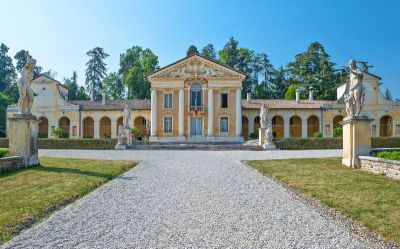If you think that the Veneto extends for miles along a featureless plain, think again. The town of Asolo is perfectly situated among the cypresses in the foothills of the Dolomites just 47 miles from Venice. It is a tiny walled town once ruled by Queen Caterina Cornaro (1454-1510), the Venetian wife of the King of Cyprus. Asolo’s 13th century castle was the home of Queen Catarina, exiled to live out her days in elegant idleness, because loyal to her native city, she had poisoned her husband so that Venice would acquire Cyprus.
Many famous inhabitants were drawn to Asolo’s beauty including Robert Browning, Freya Stark the travel writer, and the actress Eleanora Duse as well as the poet Pietro Bembo who coined the verb asolare to describe the life of pleasant indolence in the town.
The narrow, arcaded streets are charming, full of flowers and brightly painted houses with contrasting shutters line them. On the outskirts of town are lovely villas built from the 16th century onwards as the town began to attract rich families.
We spotted the quirky Longbard Villa, a small stone house close to the street. The façade is fantastically carved with sculpted figures similar to caryatids [a sculpted female figure serving as an architectural support taking the place of a column or a pillar supporting an entablature on her head] holding up the windows. More sculpted reliefs adorn the balconies.
From the main square, Piazza Garibaldi, we began the climb to the fortress for the superb views. On a clear day you can see as far as the Venetian Lagoon. Following a little lane to a 16th century former monastery, now a university building, we found a small drinking fountain. A good place to pause, have a drink and fill up a water bottle before climbing the 300 steps to the fortress.
Some of the fortress walls are 13 feet thick and there is still a tank for collecting rainwater and a large bread oven. The fortress was once used as a leper hospital after serving its purpose as a defensive fort. Venice tried - and failed - to buy it in 1650. The locals protested, even then believing it to be a part of their heritage.
Asolo Cemetery is a peaceful area often visited by fans of the actress Eleanora Duse who is buried there. Her grave is usually covered with piles of flowers.
We also visited the superb Brion Cemetery a few miles from Asolo. A masterpiece of modernist architecture, it was designed by the great Italian architect Carlo Scarpa. The various buildings are in simple grey concrete with steps, complemented with channels of water, a characteristic of Scarpa’s designs, and radiating spirituality. Most striking is an enormous heavy concrete door which slides open at the touch of a finger.
Six miles to the east of Asolo is the breathtaking Villa di Maser, also known as the Villa Barbaro. Designed by Andrea Palladio around 1550, it was built for the Barbaro brothers who also commissioned Paolo Veronese to paint the frescoes of the piano nobile, the main floor. At this time, it was fashionable for rich Venetians to build rural estates, and this villa is typical, combining the classical elegance of a country house with the buildings necessary for a working farm in the side wings. The Villa Rotunda in Vicenza is always considered the archetypal Palladian building (a sphere within a cube), but I believe the Villa di Maser is the most beautiful villa Palladio ever built. It perfectly blends symmetry, light and proportion, and is all the more charming because it is on a human scale: not a vast palazzo but a house you could imagine living in.
Given that this villa is a World Heritage Site, it is disappointing that a road runs very near the house and destroys the idyllic setting, but a small formal front garden does give photo opportunities! Behind the villa are a small pool, statuary and a grotto.
Veronese’s frescoes are sumptuous trompe l’oeil creations with the Barbaro family looking down from balustrades as you stand gazing upwards in admiration. Sixteenth century people emerge from illusory doors as you walk through the Villa’s rooms. There is a long corridor from one end of the villa to the other. At one end stands a man looking resplendent in hunting gear with a dog at his side. At the other end of the corridor, he is charmingly facing a woman who is smiling at him for all eternity.
Very close to the Villa di Maser and Asolo, in the village of Passagno, is the birthplace of the famous sculptor Canova. The tomb is inside an enormous temple which he himself designed. Nearby is the family home with the Gypsoteca (his studio and workshop) containing the plaster casts for many of his works. It is fascinating to wander around looking closely at the huge white figures often curiously riddled with small holes integral to the casting process. You begin to see and understand his working methods.
I have only described one small part of the Veneto region, which is so much more than Venice. Travel around and you will discover hidden treasures from Italy’s rich past without having to look very far. I am often amazed to discover some new place not far from home, even after living in the area for over 15 years.



